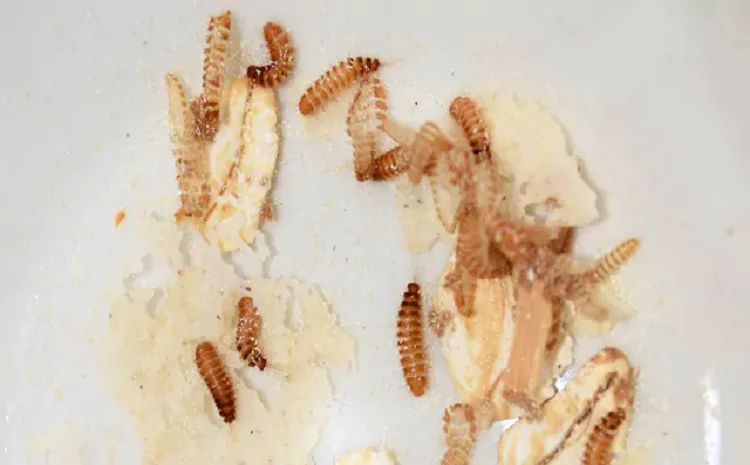Carpet beetles are common household pests that can cause significant damage to fabrics, carpets, and stored products. Understanding what carpet beetle eggs look like is crucial for early detection and effective pest control.
Key Takeaways
- Carpet beetle eggs are tiny and hard to spot.
- They are usually white or cream in color and less than 1mm long.
- Regular inspections can help in early detection and prevent infestations.
Introduction
Carpet beetles are tiny pests that can wreak havoc in your home. Their eggs, though small and inconspicuous, are the starting point of a potential infestation. Knowing what carpet beetle eggs look like can help you take preventive measures and protect your belongings.
What Are Carpet Beetles?
Carpet beetles are small insects that feed on natural fibers and can damage various household items. They go through a complete metamorphosis, including egg, larva, pupa, and adult stages. Identifying the eggs is crucial to preventing an infestation.
Appearance of Carpet Beetle Eggs
Carpet beetle eggs are:
- Small and oval-shaped: Less than 1mm long, often compared to a grain of salt.
- White or cream in color: Making them hard to see on light-colored surfaces.
- Speckled or mottled: They often appear shiny and can be mistaken for tiny dust particles.
Life Cycle of Carpet Beetles
Understanding the life cycle of carpet beetles can help in identifying and managing them effectively.
| Stage | Duration | Characteristics |
|---|---|---|
| Egg | 1-2 weeks | Tiny, white or cream-colored, less than 1mm long |
| Larva | 2-3 months | Fuzzy, carrot-shaped, vary from reddish-brown to black |
| Pupa | 1-2 weeks | Transition phase, not commonly seen |
| Adult | 2-6 weeks | Small, oval, black or brown, about 2-3mm long |
Identifying Carpet Beetle Larvae
The larvae are more noticeable than the eggs. They are:
- Fuzzy and carrot-shaped: With bristles on their bodies.
- Reddish-brown to black: Their color varies based on the species.
Where to Find Carpet Beetle Eggs
Carpet beetle eggs are often laid in hidden, undisturbed places. Common locations include:
- Carpets and rugs: Especially along edges and under furniture.
- Upholstered furniture: In seams, padding, and beneath cushions.
- Closets and storage areas: On clothing, especially wool, fur, and other natural fibers.
- Pantries and food storage areas: On dried food products and grains.
How to Detect Carpet Beetle Eggs
Detecting carpet beetle eggs can be challenging due to their size and color. Here are some tips:
- Use a magnifying glass: Helps to see the tiny eggs more clearly.
- Regular inspections: Check common areas like carpets, furniture, and storage regularly.
- Look for larvae: If you find larvae, there are likely eggs nearby.
Preventing Carpet Beetle Infestations
Prevention is key to keeping carpet beetles at bay. Here are some effective strategies:
- Regular cleaning: Vacuum carpets, rugs, and furniture frequently.
- Store items properly: Use airtight containers for food and plastic bags for clothing.
- Pest control: Consider professional pest control services if you suspect an infestation.
Carpet Beetle Control Methods
If you find carpet beetle eggs or larvae, immediate action is necessary to control the infestation.
Home Remedies
- Vacuuming: Regular vacuuming removes eggs and larvae from carpets and furniture.
- Steam cleaning: The heat from steam cleaning can kill eggs and larvae.
- Diatomaceous earth: This natural powder can be sprinkled in areas where beetles are found.
Chemical Treatments
- Insecticides: Use products specifically designed for carpet beetles. Follow the instructions carefully.
- Boric acid: This can be applied to carpets and furniture. It is toxic to insects but safe for humans and pets when used correctly.
Conclusion
Carpet beetles are more than just a nuisance; they can cause significant damage to your belongings. Identifying their eggs is the first step in preventing an infestation. By knowing what carpet beetle eggs look like and where to find them, you can take proactive measures to protect your home.
Regular cleaning, proper storage, and timely inspections are key to keeping carpet beetles at bay. If you suspect an infestation, consider professional pest control to effectively eliminate these pests.

Mark Thompson, a seasoned pest controller, is renowned for his expertise in keeping homes and businesses free from unwanted intruders. With a passion for environmental sustainability and a deep understanding of pest behavior, Mark has become a trusted authority in the industry.
